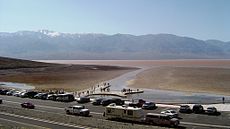Endorheic lake

An endorheic lake (also called a sink lake or terminal lake) is a collection of water within an endorheic basin, or sink, with no evident outlet.[1] Endorheic lakes are generally saline as a result of being unable to get rid of solutes left in the lake by evaporation.[2] These lakes can be used as indicators of anthropogenic change, such as irrigation or climate change, in the areas surrounding them. Lakes with subsurface drainage are considered cryptorheic.
Components of endorheic lakes
[edit]The two main ways that endorheic lakes accumulate water are through river flow into the lake (discharge) and precipitation falling into the lake.[2] The collected water of the lake, instead of discharging, can only be lost due to either evapotranspiration or percolation (water sinking underground, e.g., to become groundwater in an aquifer). Because of this lack of an outlet, endorheic lakes are mostly salt water rather than fresh water. The salinity in the lake gradually builds up through years as water evaporates and leaves its solutes behind.[citation needed]
Similar types of lakes
[edit]Depending on water losses, precipitation, and inflow (e.g., a spring, a tributary, or flooding), the temporal result of a lake in a sink may change. The lake could be a persistent lake, an intermittent lake, a playa lake (temporarily covered with water), or an ephemeral lake, which completely disappears (e. g. by evaporation) before reappearing in wetter seasons.[3] These terms (playa, ephemeral lake, etc.) are sometimes used interchangeably, but there has been activity tending towards defining meanings for each term.[4] This change would mean less confusion over the designations of different types of endorheic lakes.
Anthropogenic effects
[edit]Many endorheic lakes exist in arid or semi-arid climates.[5] Because these climates have limited rainfall, but also a high possibility of evaporation, endorheic lakes in these regions often experience flux in their water levels. This flux can be aggravated by anthropogenic intrusions (e.g. global warming).

In Central Asia, a large percentage of water for farming comes from surface water, like endorheic lakes, rather than precipitation.[2] Because of the overall lack of precipitation, farming in this area can only be sustained by irrigation. Massive amounts of irrigation in agrarian Central Asia have led to the reduction in size of endorheic lakes. The Aral Sea was once the second largest endorheic lake in the world, but anthropogenic effects such as bad irrigation practices have led to this lake's drastic decrease in size and turn into a desert named the Aralkum Desert.[citation needed]
Endorheic lakes, because of the closed nature of their systems, are sensitive to new conditions.[2] Records of previous environmental change are preserved in lake sediments in endorheic lakes that are being affected by climate change; these natural records can give information about past climates and conditions of the lake. Research on these lake sediments could lead to these lakes becoming archives of the effects of climate change. There is early evidence that in regions affected by irrigation the majority of endorheic lake area may have already been lost.[6]
List of endorheic lakes
[edit]
Africa
[edit]- Afar Depression (Great Rift Valley in East Africa)
- Lake Chad (Central Africa)
- Lake Rukwa (East Africa)
Asia
[edit]- Aral Sea (Kazakhstan; Uzbekistan)
- Caspian Sea (Iran; Azerbaijan; Russia; Kazakhstan; Turkmenistan)
- Dead Sea (Israel; Jordan; West Bank)
- Gavkhouni (Isfahan, Iran)
- Hamun-e Jaz Murian (Kerman and Sistan and Baluchistan, Iran)
- Hamun Lake (Iran)
- Lake Urmia (West Azerbaijan province, Iran)
- Lake Van (Turkey)
- Maharloo Lake (Fars province, Iran)
- Namak Lake (Qom, Iran)
- Qarhan Playa (Qinghai, China)
- Shalkar (Kazakhstan)
- Pangong Tso (Ladakh, India; Tibet, China)
Australia
[edit]North America
[edit]- Carson Sink (Churchill County, Nevada, U.S.)
- Devils Lake (North Dakota, U.S.)
- Devil's Lake (Wisconsin, U.S.)
- Lake Enriquillo (Dominican Republic)
- Etang Saumâtre (Haiti)
- Great Salt Lake (Utah, U.S.)
- Humboldt Sink (northwestern Nevada, U.S.)
- Owens Lake (Eastern Sierra, California, U.S.)
- Pyramid Lake (western Nevada, U.S.)
- Quinn River Sink (northwestern Nevada, U.S.)
- Salton Sink (southern California, U.S.)
- Eagle Lake (British Columbia, Canada)
- Choelquoit Lake (British Columbia, Canada)
- Martin Lake (British Columbia, Canada)
- Manitou Lake (Saskatchewan, Canada)
- Lake Xochimilco (Mexico City, Mexico)
See also
[edit]- Sinkhole – Geologically-formed topological depression
References
[edit]- ^ Pickles, Thomas (1956). Physical Geography. Ardent Media. pp. 107–108. ISBN 978-0460092821.
- ^ a b c d Verhoef, Anne; Samarkhanov, Kanat; Inglezakis, Vassilis J.; Sagintayev, Zhanay; Yapiyev, Vadim (2017). "Essentials of Endorheic Basins and Lakes: A Review in the Context of Current and Future Water Resource Management and Mitigation Activities in Central Asia". Water. 9 (10): 798. doi:10.3390/w9100798.
- ^ Lerman, Abraham; Imboden, Dieter M.; Gat, Joel R. (1978). The Physics and Chemistry of Lakes. Springer-Verlag Berlin Heidelberg. p. 158. ISBN 3540578919.
- ^ Briere, Peter R. (2000). "Playa, playa lake, sabkha: Proposed definitions for old terms". Journal of Arid Environments. 45 (1): 1–7. Bibcode:2000JArEn..45....1B. doi:10.1006/jare.2000.0633.
- ^ Wang, Jida; Song, Chunqiao; Reager, John T; Yao, Fangfang; Famiglietti, James S; Sheng, Yongwei; MacDonald, Glen M; Brun, Fanny; Schmied, Hannes Müller; Marston, Richard A; Wada, Yoshihide (2018). "Recent global decline in endorheic basin water storages" (PDF). Nature Geoscience. 11 (12): 926–932. Bibcode:2018NatGe..11..926W. doi:10.1038/s41561-018-0265-7. PMC 6267997. PMID 30510596.
- ^ Wine, Michael L. (2022). "Irrigation water use driving desiccation of Earth's endorheic lakes and seas". Australasian Journal of Water Resources: 1–12. doi:10.1080/13241583.2022.2141333. S2CID 253489181.
